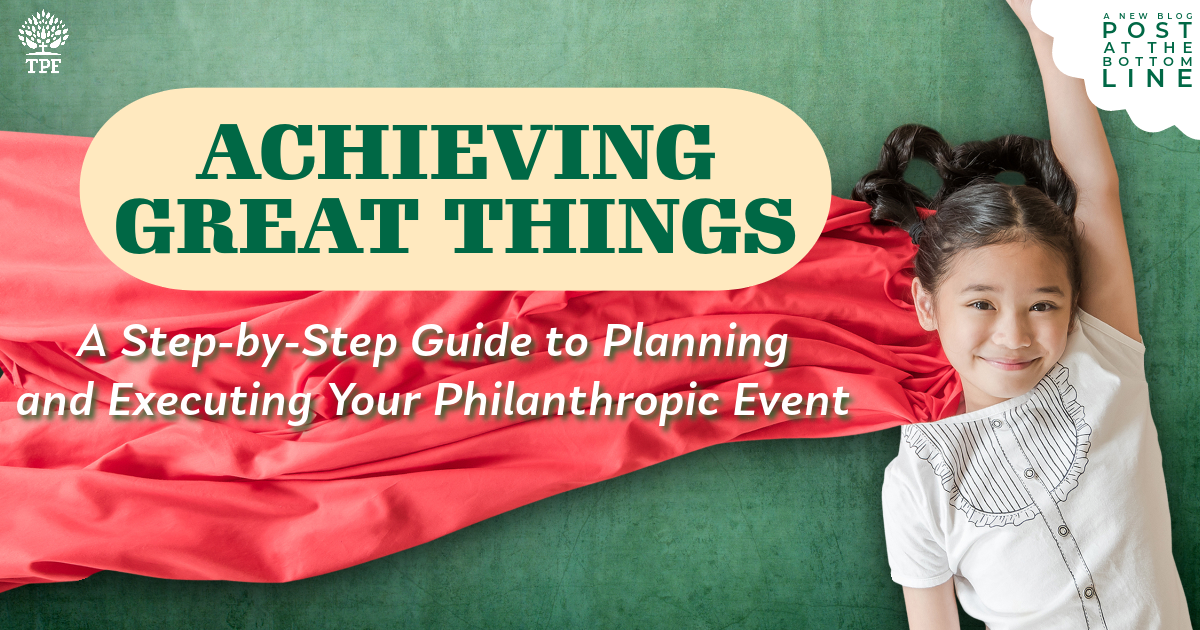ACHIEVING GREAT THINGS: A Step-by-Step Guide to Planning and Executing Your Philanthropic Event

By Stefanie Marsden, TPF Relationship Manager
As a Relationship Manager for TPF, my goal is to help our partners maximize their impact on mission. One thing I have learned over the past few years is that whether you are a church or a nonprofit, organizing a live charity event can be an effective way to raise funds and generate awareness for your cause. However, without proper planning and execution, your event may fall short of its goals. In this blog post, I will outline seven crucial steps to help you host a successful live philanthropic event. From assembling a strong leadership team to following up with attendees, these steps will guide you through the process and increase your event’s impact.
Step 1: Identify and Align a Leadership Team.
Building a capable and dedicated leadership team is essential for a successful event. Choose individuals with diverse skills and expertise who are passionate about your cause. Assign specific roles and responsibilities to team members, such as event coordination, marketing, sponsorships, and logistics. These individuals will be responsible for all aspects of these pieces including answering questions and keeping other extended team members on track. Regular communication and collaboration among team members will ensure a smooth planning process. It is this team who will come together to successfully complete Step 2 of this process.
Step 2: Define Clear and Achievable Goals.
Clearly define your philanthropic goals early in the planning process. Set a specific financial target that aligns with your church or organization’s needs and objectives. What does success look like for this event? Consider other goals as well, such as increasing awareness about your cause, building community engagement, or fostering relationships with potential donors or church members. These goals will provide a roadmap for your event planning and help measure your success. Additionally, define the type of event you will host. What will resonate with your potential donors and help you meet your newly defined goals?
Step 3: Outline a Detailed Budget.
Create a comprehensive budget that accounts for all necessary expenses. This includes possible venue rental, staff or volunteer costs, catering, entertainment, marketing materials, and any other relevant costs. Be diligent in researching and negotiating prices to stay within your budget while still delivering a memorable event. Consider alternative funding sources like sponsorships or partnerships to help cover costs and potentially increase your impact on your mission.
Pro Tip: Be sure to leave some extra room in your budget for unexpected expenses.
Step 4: Focus on Promotion and Awareness.
To ensure the success of your philanthropic event, effective PR and a marketing strategy are crucial. Develop a strategic plan that includes reaching out to local media outlets, creating press releases, leveraging social media platforms, and collaborating with influential individuals or organizations. Leverage your multichannel marketing strategy to generate excitement and buzz around your event through engaging storytelling, highlighting the impact of your cause, and showcasing the unique aspects of your event.
Step 5: Effectively Execute the Event.
Regardless of the type of event you choose to host, be sure to implement a system to manage attendee registration and maximize event attendance. Create a user-friendly online registration platform where potential attendees can easily sign up and provide necessary details. Are you selling tickets or charging a fee to attend? Consider offering early bird discounts or incentives to encourage early registrations. Communicate regularly with registered attendees to provide event updates, confirmations, and important details to ensure a smooth and engaging event experience.
Step 6: Provide Easy-To-Use Donation Vehicles.
Provide various donation options for attendees to contribute during the event. This can include traditional methods like cash and check donations, as well as modern electronic payment methods such as credit card processing or mobile payment solutions. Implement a seamless and secure system to collect donations throughout the event and make it easily accessible to attendees. Consider incorporating interactive activities or incentives to encourage higher donations.
Step 7: Focus on Gratitude and Follow Up.
Always say thank you. After the event, it’s crucial to follow up with attendees and express gratitude for their support. Send personalized thank-you emails or letters to acknowledge their contributions and attendance. Provide updates on how you are making a difference and share success stories related to your mission. Maintain open lines of communication to nurture relationships with attendees and potentially convert them into long-term supporters or volunteers.
Organizing a philanthropic event involves meticulous planning and execution, but with these seven steps, you can significantly increase your chances of success. By following these steps, you can create an impactful event that not only raises funds but also strengthens community support for your cause. Are you interested in learning more? CLICK HERE to visit our TPF Legacy Builder tool for more information about how TPF can help you enable and expand your mission. Or, if you have any questions, please CLICK HERE to schedule an appointment or send me an email.